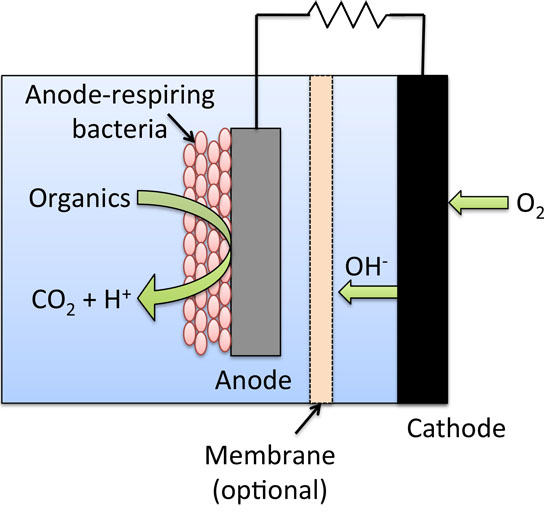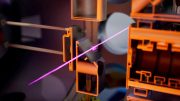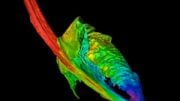
This graphic shows the basic setup for a microbial fuel cell. An MFC consists of an anode, a cathode, a proton or cation exchange membrane and an electrical circuit. Anode respiring bacteria cling to the anode of the MFC. In the course of their metabolic activity, these bacteria strip electrons from organic waste. The electrons then flow through a circuit to the cathode, producing electricity in the process, in addition to CO2 and water. Hydroxide or OH- ions are transported from the cathode into the surrounding electrolyte. Credit: The Biodesign Institute at Arizona State University
In an effort to provide a sustainable system for waste treatment and energy production, scientists at Arizona State University’s Biodesign Institute are working microbial fuel cells or MFCs, which target electrons from waste streams and convert them into useful energy.
Some of the planet’s tiniest inhabitants may help address two of society’s biggest environmental challenges: how to deal with the vast quantities of organic waste produced and where to find clean, renewable energy.
According to César Torres and Sudeep Popat, researchers at Arizona State University’s Biodesign Institute, certain kinds of bacteria are adept at converting waste into useful energy. These microorganisms are presently being applied to the task, through an innovative technology known as a microbial fuel cell or MFC.
As Torres explains, “the great advantage of the microbial fuel cell is the direct conversion of organic waste into electricity.” In the future, MFC’s may be linked to municipal waste streams or sources of agricultural and animal waste, providing a sustainable system for waste treatment and energy production.
To scale up the technology, however, improvements in efficiency will be required. “My particular focus is to understand at a fundamental level how anode respiring bacteria transfer electrons from their cells onto an electrode,” Popat says, “as well as to design new systems that are both economical and efficient.”
The group was able to demonstrate that significant loss in MFC efficiency was due to reactions occurring at the fuel cell’s cathode. By modifying materials used in the cathode, as well as adjusting pH levels, they were able to improve cathode performance.
The group’s research results appeared recently in the journal ChemSusChem in a special issue devoted to MFC technology.
Torres and Popat work in Biodesign’s Swette Center for Environmental Biotechnology, directed by ASU Regents’ professor Bruce Rittmann – a co-author of the current study. Environmental biotechnology is a rapidly developing discipline in which disparate fields including microbiology, bioinformatics, chemistry, genomics, materials science, and engineering join together to harness biological entities – including bacteria – for the purpose of helping society.
Two chief areas of environmental biotechnology are bioremediation, or the clean up of environmental contaminants, and the production of clean energy. As the authors note, an MFC can perform double duty, targeting electrons from waste streams and converting them into useful energy.
An MFC is a unique kind of battery – part electrochemical cell, part biological reactor. Typically, it contains two electrodes, separated by an ion exchange membrane. On the anode side, bacteria grow and proliferate, forming a dense cell aggregate known as a biofilm that adheres to the MFC’s anode. In the course of their microbial metabolism, the bacteria act as catalysts for converting the organic substrate into CO2, protons, and electrons.
Under natural conditions, many bacteria use oxygen as a final electron acceptor to produce water, but in the oxygen-free environment of the MFC, specialized bacteria that send the electrons to an insoluble electron acceptor, namely the MFC’s anode, dominate.
The anode-respiring bacteria are able to oxidize organic pollutants, such as those found in waste streams, and transfer the electrons to the anode. The scavenged electrons then flow through an electrical circuit, terminating at the MFC’s cathode, thus generating electricity. Ions are transported through the fuel cell’s ion membrane, to maintain electroneutrality, although the membrane is often excluded.
In an effort to refine the technology and address losses in MFC efficiency, the group looked at the oxygen reduction reaction at the MFC cathode. While it had earlier been speculated that efficiency loss at the cathode was due to a low availability of protons, the new research showed instead that the transport of hydroxide ions (OH-) away from the catalyst layer of the cathode and into the surrounding liquid largely governed cathode potential losses in the device.
“We found that the cathodes were limiting the power densities we can produce in these MFCs,” Popat says. “This is very surprising because, in chemical fuel cells, the same catalyst allows much greater power densities.”
A key to the disparity lies in the fact that MFC’s, unlike chemical fuel cells, must operate at neutral pH in the anode chamber to ensure optimum growth and activity of the microorganisms catalyzing the reactions. At the cathode, OH- ions cause a local increase in pH, due to a limiting rate of their transport. Further, every unit of pH increase at the cathode results in a loss of 59 millivolts of energy – the authors found that the local cathode pH could easily reach >12, representing a substantial loss.
To attempt to remedy this situation, the group conducted a detailed examination of transport properties at the cathode. An ion exchange binder contained in the cathode usually assists transport of ions to the surrounding electrolyte. Normally, this binder is made from a material called Nafion, which the authors explain is good for transporting positively charged cations like protons, but a poor conductor of negatively charged anions like the hydroxide ions that accumulate at the MFC cathode, or anionic buffer species, such as phosphates and bicarbonates, that help transport OH- ions.
An experimental polymer known as AS-4, which has high anion-exchange capacity, was substituted for Nafion as a cathode binder in the study. The modification ensured the efficient transport of hydroxide ions and improved the performance of the cathode. The study showed that OH- transport could be further enhanced by adjusting pH directly, though the addition of CO2 mixed with air as a buffer for the cathode catalyst.
The study represents the first comprehensive analysis of cathode limitations in MFC’s and will further the development of these systems through refinement of materials and operating conditions.
“The main importance of our study is not to provide immediate answers, but to conduct a mechanistic study to determine how the cathode operates and identify the sources of inefficiency,” Torres explains. “Now we can begin to work on solutions.”
Reference: “Importance of OH− Transport from Cathodes in Microbial Fuel Cells” by Dr. Sudeep C. Popat, Dongwon Ki, Dr. Bruce E. Rittmann and Dr. César I. Torres, 21 May 2012, ChemSusChem.
DOI: 10.1002/cssc.201100777








Be the first to comment on "Converting Waste Into Useful Energy by Improving Microbial Fuel Cells"